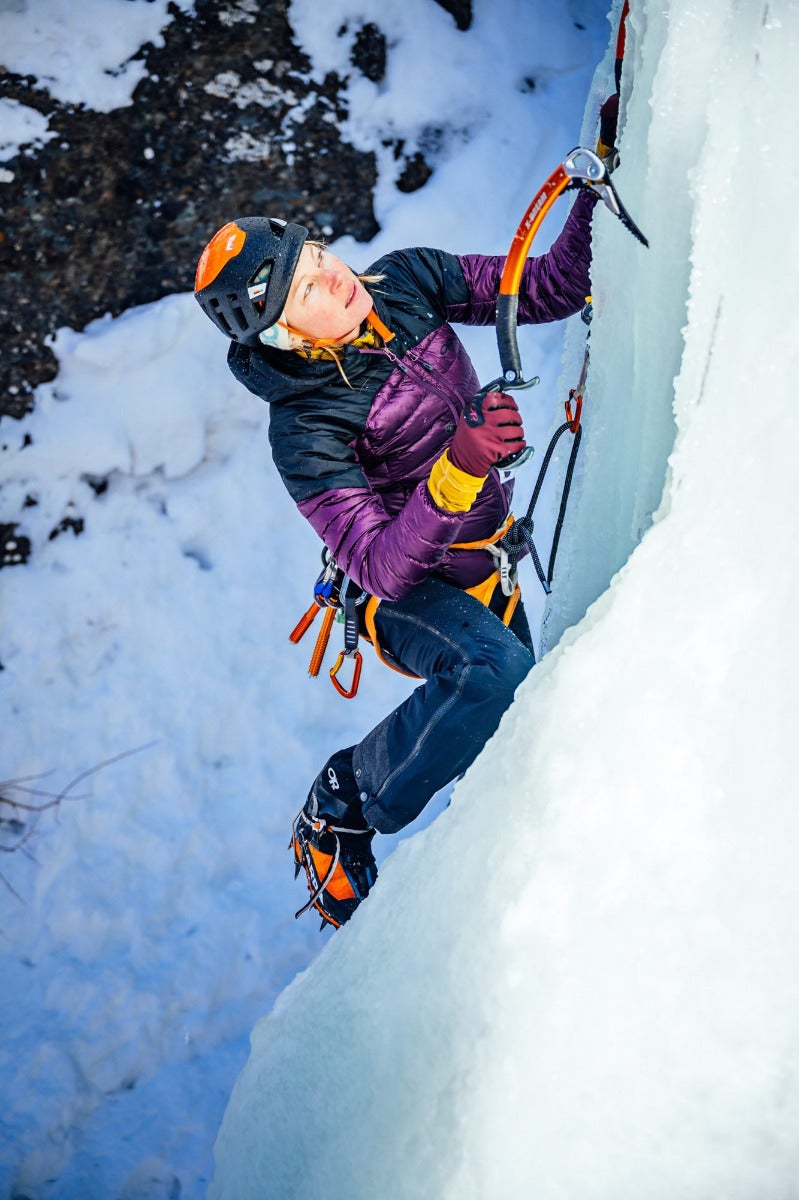“After noticing my clumsiness around ropes and gear, one of the guests had to lend me a pair of their warm, dry, synthetically insulated gloves,” she says. It saved the day—and cemented a lesson she will never forget: always pack an array of gloves for ice climbing.
RELATED: How To Layer For Ice Climbing

Emilie Drinkwater has climbed and skied all over the world, with first ascents and descents in the Adirondacks, Alaska, the Karakoram and the Hindu Kush. She’s the 9th American woman and 100th American mountain guide to be certified at the highest level of training and credential attainable by a professional mountain guide. She has been guiding ice climbing and teaching clinics for 18+ years. She learned the hard way that ice climbing requires a fleet of gloves, and over the course of years has refined her fleet of gloves to the perfect collection.
We asked Emilie to share what gloves she packs for ice climbing and why.
How many different pairs of gloves do you pack for ice climbing?
Of course it will always ultimately depend on venue and weather, but four pairs of gloves or mitts is pretty standard for me.
What kinds of gloves and mitts do you pack for ice climbing?
I typically have one pair of liner gloves, a pair of dexterous leather-palmed climbing gloves, a pair of slightly warmer dexterous leather-palmed gloves, and also a pair of warm belay gloves—or, for really cold weather, mittens.
What are all the different gloves for? When do you wear each one?
For all but the hardest climbing, I always wear liners underneath. Liners add warmth, wick away sweat, and allow nimble fingers without completely exposing my hands to the cold if I need to take the outer glove off.
On top of my liners I wear either a light glove (for harder climbing) or a midweight glove (for colder temperatures and easier climbing). I nearly always switch to a belay glove for belaying, resting, or hanging out so I keep my climbing gloves dry for climbing.


If the weather is really cold or really wet and I'm resting or belaying, I might wear mittens (with liners). For wet weather I like to put an oversized shell mitt over my gloves.
While I’m not using them, my climbing gloves live under my armpits (one of the few warm places on my body on a cold day of climbing!) and between my mid layers.


What do you often see people get wrong about choosing gloves for ice climbing?
It's a common misperception that a big, bulky glove will keep your hands warm while ice climbing. In fact, they tend to do the opposite. Bulky gloves make it harder to properly grip an ice tool, which in turn causes over-gripping. Over-gripping in cold weather, while simultaneously having your hands above your head and being scared, is a recipe for frozen hands.
Another way to think about it: If you put something hot in an insulated thermos, the thermos keeps the liquid hot. Put something cold in it, the thermos keeps it cold. Your hands are no different. In order to have warm hands, you have to generate heat no matter what glove you're wearing. So even though I’m a notoriously cold-handed person, I find that wearing lighter weather-resistant gloves allows for the most dexterity and best grip. If I have this, I feel less scared and pumped. In order to actually generate hand heat, I do a lot of shaking out and pretty much always have chemical hand warmers available.

Any other tips for choosing the right gloves?
Get ready to purchase a small fleet! Liners, dexterous climbing gloves and a warm belay glove or mitt is a minimum and should set one up for success.
Also, make sure the climbing gloves fit—err on the small side. I actually aim for gloves that are a little too small (kind of like rock climbing shoes). If they have leather in them (recommended) they'll stretch with use. If there's insulation, even just a little, that will pack out with use. There's nothing worse than a glove that's too big! If the fingers are too long, they fold over and catch on everything—carabiners, zippers, rope—and you'll find yourself constantly wanting to take them off for tasks.
RELATED: Ice Climbing Etiquette
Taking gloves off (though liners help) a lot in cold weather, sets you up for cold hands and the possibility of dropping a glove (less than ideal if you're many pitches up).
How do you care for gloves to make them last longer and perform better?
If you ice or snow climb a lot, you will go through gloves like candy. You can make them last longer by routinely using a conditioning and/or waterproofing wax, balm or oil. My favorite is beeswax based Sno-Seal but I've also used Nikwax and mink oil. I use these conditioners any time the leather starts to look or feel cracked and dry, if not sooner. Taking care of the leather keeps the gloves supple, grippy and water resistant.
It's also common for my gloves to eventually tear or fray at the seams, especially on my dominant thumb and pointer finger. Again, if you climb a lot, particularly in wet conditions, this will happen (it's usually not poor manufacturing as much as it is use). When I begin to see seams blowing out, I'll try to immediately start repairs by using waxed floss and a heavy duty needle to stitch the hole or tear back together. I often follow this with seam seal (like for tents) to additionally protect and waterproof the repair.


